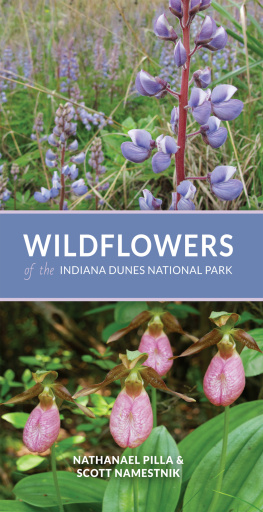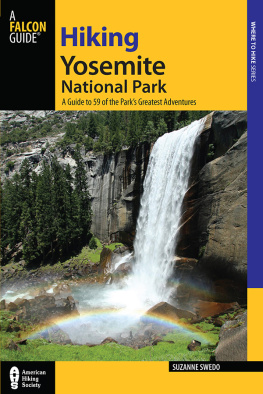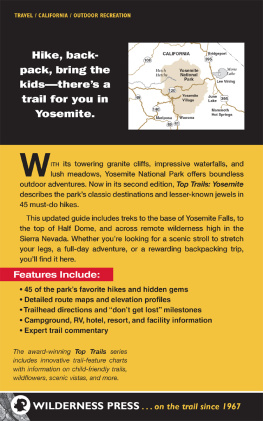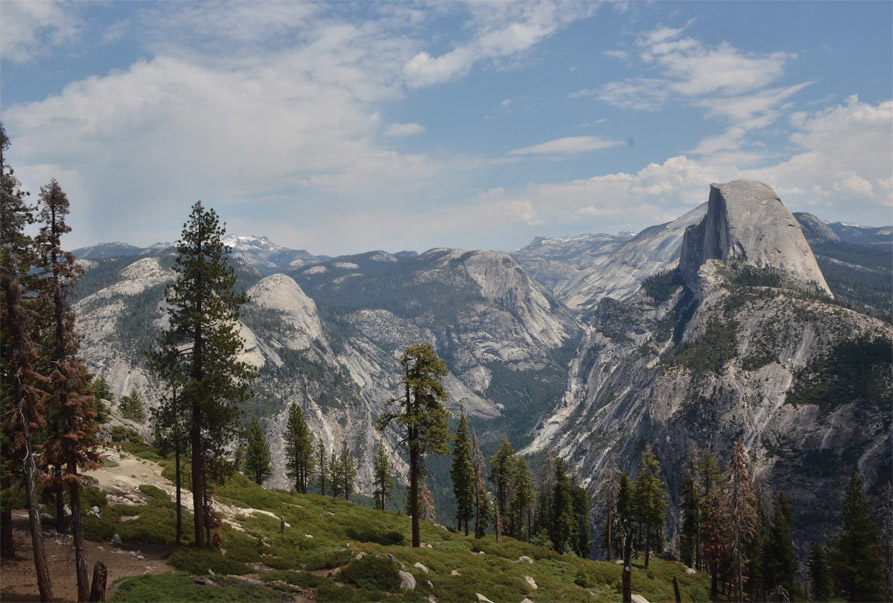CONTENTS
Guide
Judy and Barry grew up several states apart from each other. Both of them developed an interest in nature in their early years. Judy spent her childhood years in Fort Worth, Texas, and Barry spent his in the San Francisco Bay Area. In their formative years, they both spent much of their time outdoors, learning about their native flora and fauna. Barry became a California State Park ranger and eventually found his perfect niche at Henry W. Coe State Park, which is the second largest state park in California and is located in the rugged ridges of the Inner South Coast Ranges. Judy moved to California in 1981 and began backpacking and hiking in the beautiful parks and open spaces that have been preserved in the Bay Area. In 1987, when she got back to park headquarters after a glorious three-day backpacking trip at Coe Park, she went straight to the visitor center, without thinking to remove her backpack, and asked a volunteer how she could become involved with the park. She became a uniformed Coe Park volunteer in 1988, spent much time in the park learning the plants, and started leading wildflower walks in 1990. In 1995, Judy and Barry got married, and in 2007 they retired and moved to Greeley Hill, in the central Sierra Nevada foothills, about 35 minutes from Yosemites Big Oak Flat entrance. Since that time theyve spent many hours in the park, becoming familiar with its plants and animals. They used the resources available to learn the plants, but longed for a comprehensive Yosemite wildflower guide that would be small enough to fit in a book bag. Eventually, they decided theyd have to write one.
Our botany buddy Doug Krajnovich edited and proofread all the text at least three times and suggested quite a few valuable improvements. He also let us use several of his photographs. Lynn Robertson, another botany buddy, and Dave Jigour, our esteemed neighbor, also provided photographs for the book.
Alison Colwell, Peggy Moore, and Garrett Dickman, former and present Yosemite botanists, have given us all sorts of useful information and have provided encouragement as well. Jennie Haas, botanist for the Stanislaus National Forest, provided plant location information and lots of encouragement.
Steve Schoenig (known fondly by many as Mr. Monkeyflower) helped us sort out the latest monkeyflower changes and provided a photo for the book.
Several photographers allowed us to use photos that we selected from their collections on the CalPhotos website. Those generous photographers, listed in alphabetical order, are Michael Charters, Debra Cook, John Doyen, John Game, George W. Hartwell, Neal Kramer, Steve Matson, Keir Morse, Anuja Parikh and Nathan Gale, Jean Pawek, Steven Perry, Aaron Schusteff, Mike Spellenberg, and Dean Wm. Taylor. Their photographs are listed in the photographer credits section on page 322.
We constantly make use of Jepson eFlora (ucjeps.berkeley.edu/eflora) in conjunction with The Jepson Manual: Vascular Plants of California, second edition, 2012. We used the online manual, which is frequently updated, as the authority for the family classifications, scientific names, and plant information in this book.
The Calflora website (calflora.org) is another resource that we find incredibly useful and that we highly recommend. You can use the website to find out what plants grow where, and you can use their location information to locate plants in the field. You can also designate an area on a map and retrieve an illustrated list of the plants that grow in the area.
The plant section of the CalPhotos website (calphotos.berkeley.edu/flora) is one of our most indispensable resources. The CalPhotos site was established in 1995, when the Internet was just getting going, and it was one of the first online image databases specializing in natural history subjects. At this writing, the site had more than 370,000 plant photos, a number that grows every day.
We also frequently refer to An Illustrated Flora of Yosemite National Park, 2001, by Stephen J. Botti. When were not out in the field with the book, it usually sits open on our desk. Unfortunately, the book is out of print, but copies are still available online.
We highly recommend Michael Charters California Plant Names website. His botanical name derivations pages (calflora.net/botanicalnames/index2.html) explain the meanings of botanical names. He also provides detailed information about the people for whom plants have been named. If you want help deciding how to pronounce botanical names, youll probably want to bookmark his pronunciation guide (calflora.net/bloomingplants/pronunciationguide.html).
We also recommend A Field Guide to Pacific State Wildflowers, 1976, by Theodore F. Niehaus and Charles L. Ripper. Although the book is somewhat old, its still quite useful, and even experienced botanists carry it in the field.
Quite a few botanical name changes have taken place in Jepson eFlora somewhat recently.
Family changes
Some of the more significant family changes are described below.
Several years back, the borage family (Boraginaceae) was expanded to include all members of the waterleaf family (Hydrophyllaceae) family.
More recently, several genera in the snapdragon family (Scrophulariaceae) were moved to other families. The Castilleja, Cordylanthus, Orthocarpus, and Pedicularis genera (plural of genus) were moved to the broomrape family (Orobanchaceae). The Antirrhinum, Collinsia, Digitalis, Gratiola, Keckiella, Lindernia, Penstemon, and Veronica genera were moved to the plantain family (Plantaginaceae). The California native monkeyflowers, previously in the Mimulus genus, were assigned to the Diplacus, Erythranthe, and Mimetanthe genera and were moved to the lopseed family (Phrymaceae). The Scrophularia and Verbascum genera remain in the snapdragon family.
A number of genera in the lily family (Liliaceae) have been assigned to different families. The Allium genus was moved to the onion family (Alliaceae). The Brodiaea, Dichelostemma, and Triteleia genera were moved to the brodiaea family (Themidaceae). The Camassia and Chlorogalum genera were moved to the century plant family (Agavaceae). The Narthecium genus was moved to the bog asphodel family (Nartheciaceae) family. The Tofieldia genus was renamed Triantha and was moved to the false-asphodel family (Tofieldiaceae). The Smilacina genus was renamed Maianthemum and was moved to the butchers-broom family (Ruscaceae). The Zigadenus genus was renamed Toxicoscordion and was moved, along with the Trillium and Veratrum genera, into the false-hellebore family (Melanthiaceae). The Calochortus, Clintonia, Erythronium, Fritillaria, Lilium, and Prosartes (previously Disporum) genera remain in the lily family.
Yosemite native plants that were in the purslane family (Portulacaceae) have been moved to the miners lettuce family (Montiaceae).
Plants that were in the milkweed family (Asclepiadaceae) have been moved to the dogbane family (Apocynaceae).
Plants in the Sambucus genus have been moved from the honeysuckle family (Caprifoliaceae) to the muskroot family (Adoxaceae).
Genus changes
Some of the more significant genus changes are listed below.
Sunflower family (Asteraceae). Yosemite plants in the Aster genus have been moved to the Eucephalus, Eurybia, Oreostemma, Sericocarpus






